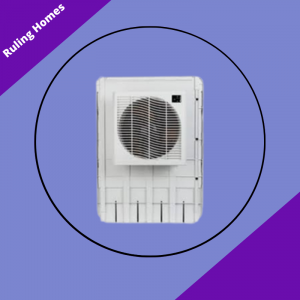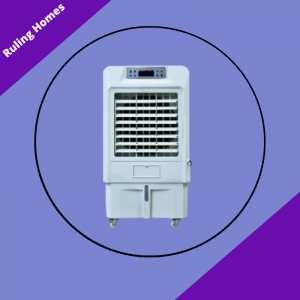An evaporative cooler works by the outdoor air passing through its water-saturated pads. It gradually reduces the temperature of air by 15⁰- 40⁰F. In other words, it uses water evaporation to cool the air.
The common type of material used in an evaporative cooler is plastic. It also comes in hard iron, heavy-duty steel, and stainless steel. The quality of the material used in its manufacturing determines the price and longevity of the evaporative cooler.
Usually, a high-quality evaporative cooler successfully cools the air to an ideal temperature in warm regions with higher efficiency.
The stainless steel evaporative cooler lasts longer than any other type as it is rust-free and gives long-lasting properties. Water is the primary element; the stainless steel evaporative cooler ensures that it does not get corroded and works for long-term.
Plastic and hard iron evaporative cooler are also good options, but they are best for home-based service. The durability and longevity of the machine depends on the frequency of use
The history of the evaporative cooler can be dated back to the ancient times when Egyptians and Persians used the windcatcher. They caught the wind air passed over the accumulated water in their ‘Qanat’ and discharged the cool air to the building. It was necessary due to the blazing heat in the gulf regions.
Later, Iranians used the same method in their houses. Over time evaporative coolers were considered the basic necessity of dry and hot regions. In 1908, Oscar Palmer of Phoenix was credited with inventing an evaporative cooler. He designed the home-based evaporative cooler, which later appeared in Arizona in large numbers.
Table of Contents
What Is The Ideal Material For An Evaporative Cooler?
The ideal material for an evaporative cooler is stainless steel. Stainless steel evaporative cooler is preferred because of its long-lasting and rust-free properties. It is also durable and damage resistant.
Stainless steel evaporative cooler costs more than any other type. A plastic-based evaporative cooler is the cheapest, but it is designed for small houses and won’t last long.
The longevity and durability of an evaporative cooler depend on the frequency of use. It works differently for residential and commercial purposes. An evaporative cooler to cool a large area will require an efficient ventilation system to perform the key function properly.
People concerned about environmental health might want to consider the evaporative cooler that makes less noise. Try to fix the cooler away from the neighbors, as you won’t be able to control its noise.
What Are The Different Types Of Evaporative Coolers?
There are two major types of evaporative coolers.
Direct evaporative cooler: It is mostly referred to as a swamp cooler and is often used as a portable cooler. It can cool the air by directly spreading the vapors in the room. Constant vapors in the air cause the room temperature to decrease.
Indirect evaporative cooler: It is mounted to the wall or window. It gradually decreases the indoor temperature by sucking the outdoor air through its water-soaked grills. It is not a portable machine.
What Is The Ideal Size Of An Evaporative Cooler?
The ideal size of the evaporative cooler depends on the frequency of use. It works differently for residential and commercial purposes. Normally an evaporative cooler with a big motor and fan is suitable for industries and giant buildings.
What size evaporative cooler do I need? It typically depends on the frequency of use. First, you need to check the room or floor you want to cool. Multiply the square feet needed to be cooled by the ceiling height and then divide it by two; it will give you the CFM of the cooler necessary to cool down the room.
Normally a 2500-3000 CFM evaporative cooler is enough for 1000 square feet of room. It will outperform the function and will cool the air as desired.
You might also want to consider the power of the evaporative cooler. The evaporative cooler consuming less and more stable power is more likely to survive longer. Always consider the power of the evaporative cooler matches your power supply.
What Are The Use Cases Of An Evaporative Cooler?
Some use cases of an evaporative cooler are given below:
- Spread moisture in the air
- Fights with the dryness of the surrounding atmosphere
- Effective in limiting the dry nose and throat
- Provides fresh air
Once you have installed the evaporative cooler, you will get to know more use cases of this machine.
Is an evaporative cooler good for health?
Yes, as evaporative coolers use moisture for cooling the air. It will not dry your nose and skin.
Is the evaporative cooler better than a fan?
Yes, the evaporative cooler is better because the fan is only designed to spread the air, whether hot or cold, while the evaporative cooler gives proper moisture to the air.
Where do evaporative coolers work best?
It works best in dry regions where water evaporates quickly and cools the air.
Do you need to have a window open with evaporative cooling?
Evaporative coolers do need proper ventilation. It works by sucking the outdoor air into the room, and there must be a way out to this air.
What Are The Best Evaporative Cooler Brands?
The best evaporative cooler brands include:
Best overall evaporative cooler: HESSAIRE
Best eco-friendly evaporative cooler: Arctic Air
Best value evaporative cooler: Orgtoy
Best cost-friendly evaporative cooler: Frigidaire
What Is the Lifespan Of An Evaporative Cooler?
The average lifespan of an evaporative cooler is 15-20 years. It depends on the quality and the type of brand you have. Also, by keeping up the routine checkup, the lifespan of an evaporative cooler can be increased.
Some other factors on which the lifespan of an evaporative cooler depends:
- Maintenance
- Usage
- Power supply
- Quality
The average cost of an evaporative cooler varies from $50-$500, depending on the size of the cooler. The big size cooler with a large water tank will cost more.
How Does Culture Affect The Usage Of An Evaporative Cooler?
Evaporative coolers took to every house right after its invention. People were already using alternate ways to bring cool, moist air to their houses. An evaporative cooler is a perfect machine for dry and hot areas. It efficiently cools the air with proper moisture.
People use evaporative coolers for different purposes in different regions of the world. It is used in farmhouses for animals, used in hospitals to spread fresh and cool air inside.
What Are The Alternatives For An Evaporative Cooler?
Exhaust fan: It works similarly to an evaporative cooler. Both are used to maintain good and fresh air inside. But an exhaust fan is typically designed to remove bad odor and humidity.
Ceiling fan: It works in parallel with the evaporative cooler. Both are used to provide cool and fresh air. The ceiling fan’s only job is to spread, hot or cold air. It depends on the current temperature of the room.
Air conditioner: It also works similarly to the evaporative cooler. But the air conditioner is more often used to decrease the temperature to lower levels. It gives you the feel of winter in extremely hot weather.
What Are The Features Of A Superior Evaporative Cooler?
Some of the best features of evaporative coolers are:
Maintain moisture: Evaporative cooler is perfect for maintaining the room’s moisture.
Fresh air: You can bring fresh air by fixing the evaporative cooler outside the house.
High quality: A high-quality evaporative cooler will serve the key purpose for longer durations without a routine checkup.
Cools the air: A super powerful evaporative cooler tends to cool the surrounding air in comparatively less time.
What Are The Parts Of An Evaporative Cooler?
Parts of an evaporative cooler include:
Evaporative pads: There are evaporative pads on cooler’s side that soak water and spread in the form of fumes adding a cool effect inside.
Water pump: It is responsible for circulating the water from the container to the pads of the cooler.
Motor: It distributes the required power to the evaporative cooler for functioning.
Float valve: It maintains the balance of water inside the container. Automatically turns off the water supply when it reaches a maximum level.
Distributing tubes: These are the channels through which water travels to every corner of the evaporative pads.
How Did An Evaporative Cooler Get Its Name?
The name is clear. Evaporative coolers are used to give moisture to the air. They maintain a proper humid and fresh air inside the house. People were using old methods of getting moist air in their houses, but the evaporative cooler is extremely powerful in serving the same purpose.
It proved to be an efficient machine in hot and dry regions. People worldwide call it by different names. It is also called a swamp cooler, desert cooler, and wet air cooler.
What Is The History Of The Evaporative Cooler?
The history of an evaporative cooler comes from ancient times when Egyptians and Persians used the windcatcher. They passed the air through the water stored in their Qanat and discharged it to their buildings for cool and misted air.
In 1908, Oscar Palmer of Phoenix invented the evaporative cooler; the design was simple and homemade and later appeared in big markets in enormous numbers. Today, we see the most advanced form of an evaporative cooler.

I grew up on a small farm in New Jersey. We had a big family because my parents, my uncles and aunties all were living together on this farm so, you can imagine, it was always over crowded with people. But living in farm was really great because we had to do everything on our own and I learned so many things from my parents and uncles and aunties and that is where I found my passion for fixing things, whether it is renovating or designing, I was always there. Read more


